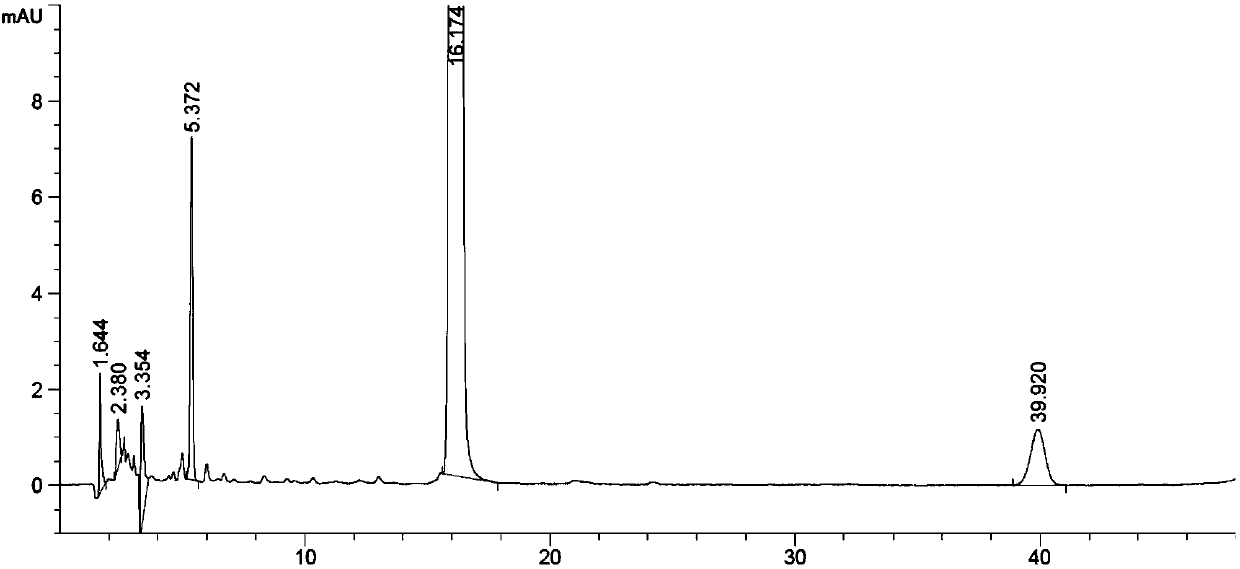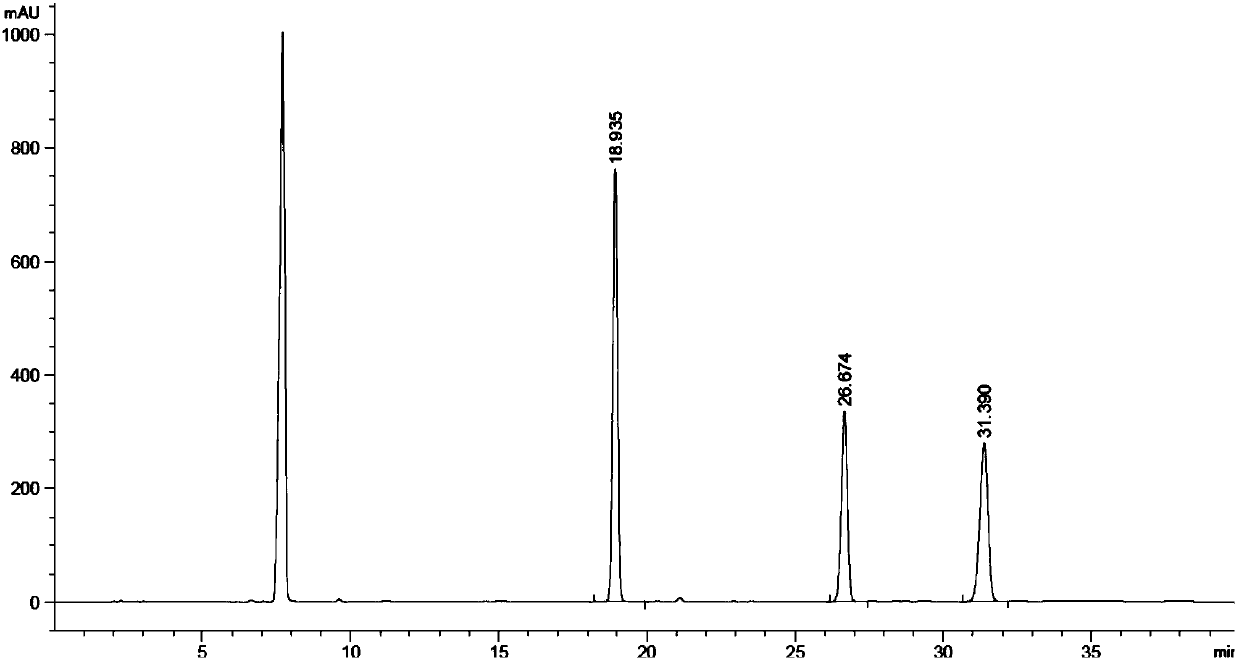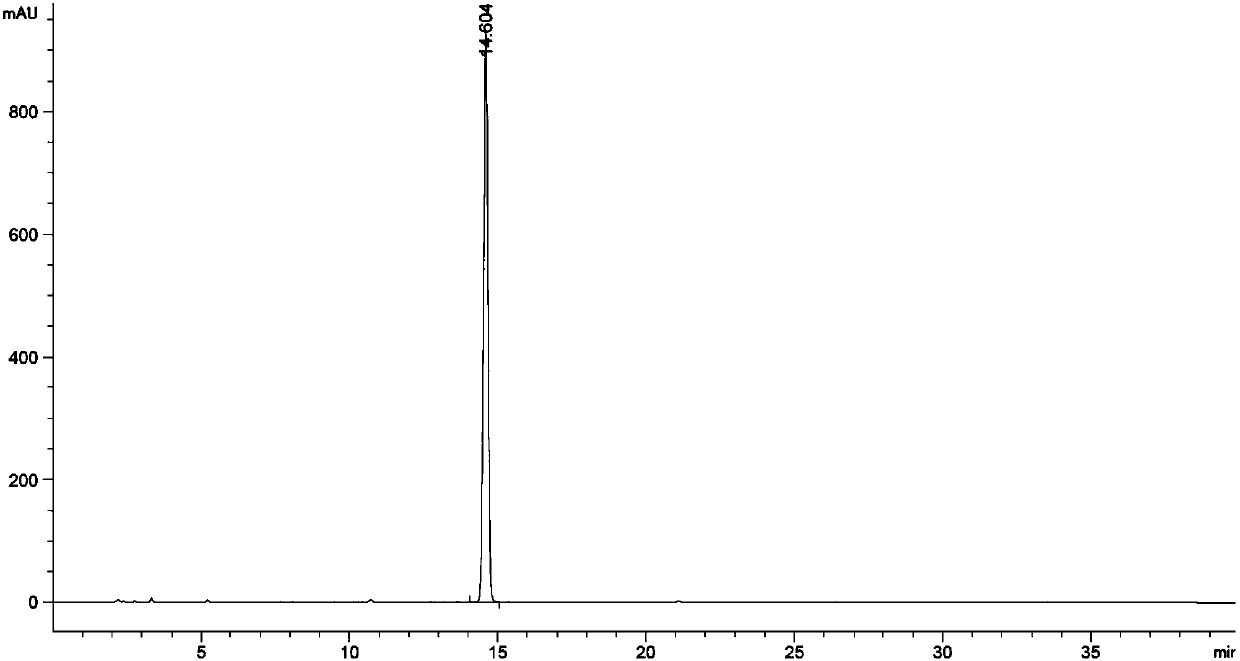HPLC analysis method of key intermediate impurities for dipyridamole synthesis
An analytical method and dipyridamole technology are applied in the field of HPLC analysis of key intermediate impurities in the synthesis of dipyridamole, and achieve the effect of ensuring controllability, strong specificity and good resolution
- Summary
- Abstract
- Description
- Claims
- Application Information
AI Technical Summary
Problems solved by technology
Method used
Image
Examples
Embodiment 1
[0035] Embodiment 1 isocratic elution (comparative experiment)
[0036] Instruments and Conditions
[0037] High performance liquid chromatography: Agilent 1260
[0038] Chromatographic column: Octadecylsilane bonded silica gel column (Bondapak4.6×250mm, 5μm)
[0039] Flow rate: 1.0mL / min
[0040] Detection wavelength: 220nm
[0041] Column temperature: 25°C
[0042] Diluent: Chloroform-acetonitrile
[0043] Injection volume: 10μL
[0044] Mobile phase: acetonitrile: water = 92:8
[0045] Experimental procedure
[0046] Accurately weigh 50mg of dichloride, put it in a 50mL measuring bottle, add chloroform to dissolve, add acetonitrile to dilute to the volume, shake well, and use it as the test solution. Carry out high performance liquid chromatography analysis by above-mentioned condition, record chromatogram, the result sees attached figure 1, the retention times of trichloride and monochloride relative to dichloride are 0.33 and 2.47, respectively. Although the sep...
Embodiment 2
[0048] Instruments and Conditions
[0049] High performance liquid chromatography: Agilent 1260
[0050] Chromatographic column: phenylsilane bonded silica gel column (Kromasil 4.6×250mm, 5μm)
[0051] Flow rate: 1.0mL / min
[0052] Detection wavelength: 220nm
[0053] Column temperature: 25°C
[0054] Diluent: Chloroform-acetonitrile
[0055] Injection volume: 10μL
[0056] Mobile phase: mobile phase A: acetonitrile solution containing 0.1% phosphoric acid; mobile phase B: aqueous solution containing 0.1% phosphoric acid
[0057] Gradient elution:
[0058]
[0059] Experimental procedure
[0060] Step 1: Solution preparation
[0061] System suitability solution: Weigh the appropriate amount of tetrachloride, trichloride, dichloride and monochloride reference substance respectively, weigh them accurately, add appropriate amount of chloroform to dissolve, and dilute with acetonitrile to make about 0.5mg in each 1mL The mixed reference substance, as a system suitabili...
Embodiment 3
[0070] Instruments and Conditions
[0071] High performance liquid chromatography: Agilent 1260
[0072] Chromatographic column: phenylsilane bonded silica gel column (Kromasil 4.6×250mm, 5μm)
[0073] Flow rate: 1.1mL / min
[0074] Detection wavelength: 210nm
[0075] Column temperature: 22°C
[0076] Diluent: Chloroform-acetonitrile
[0077] Injection volume: 10μL
[0078] Mobile phase: mobile phase A: methanol solution containing 0.1% phosphoric acid; mobile phase B: aqueous solution containing 0.1% phosphoric acid
[0079] Gradient elution:
[0080]
[0081] Experimental procedure
[0082] Experimental procedure is with embodiment 2, and the result sees attached Figure 4 , the retention times of trichloride and monochloride relative to dichloride are 0.85 and 1.08 respectively, and the results of tetrachloride are shown in the appendix Figure 5 , the retention time relative to dichloride is about 0.72.
PUM
 Login to View More
Login to View More Abstract
Description
Claims
Application Information
 Login to View More
Login to View More - R&D
- Intellectual Property
- Life Sciences
- Materials
- Tech Scout
- Unparalleled Data Quality
- Higher Quality Content
- 60% Fewer Hallucinations
Browse by: Latest US Patents, China's latest patents, Technical Efficacy Thesaurus, Application Domain, Technology Topic, Popular Technical Reports.
© 2025 PatSnap. All rights reserved.Legal|Privacy policy|Modern Slavery Act Transparency Statement|Sitemap|About US| Contact US: help@patsnap.com



